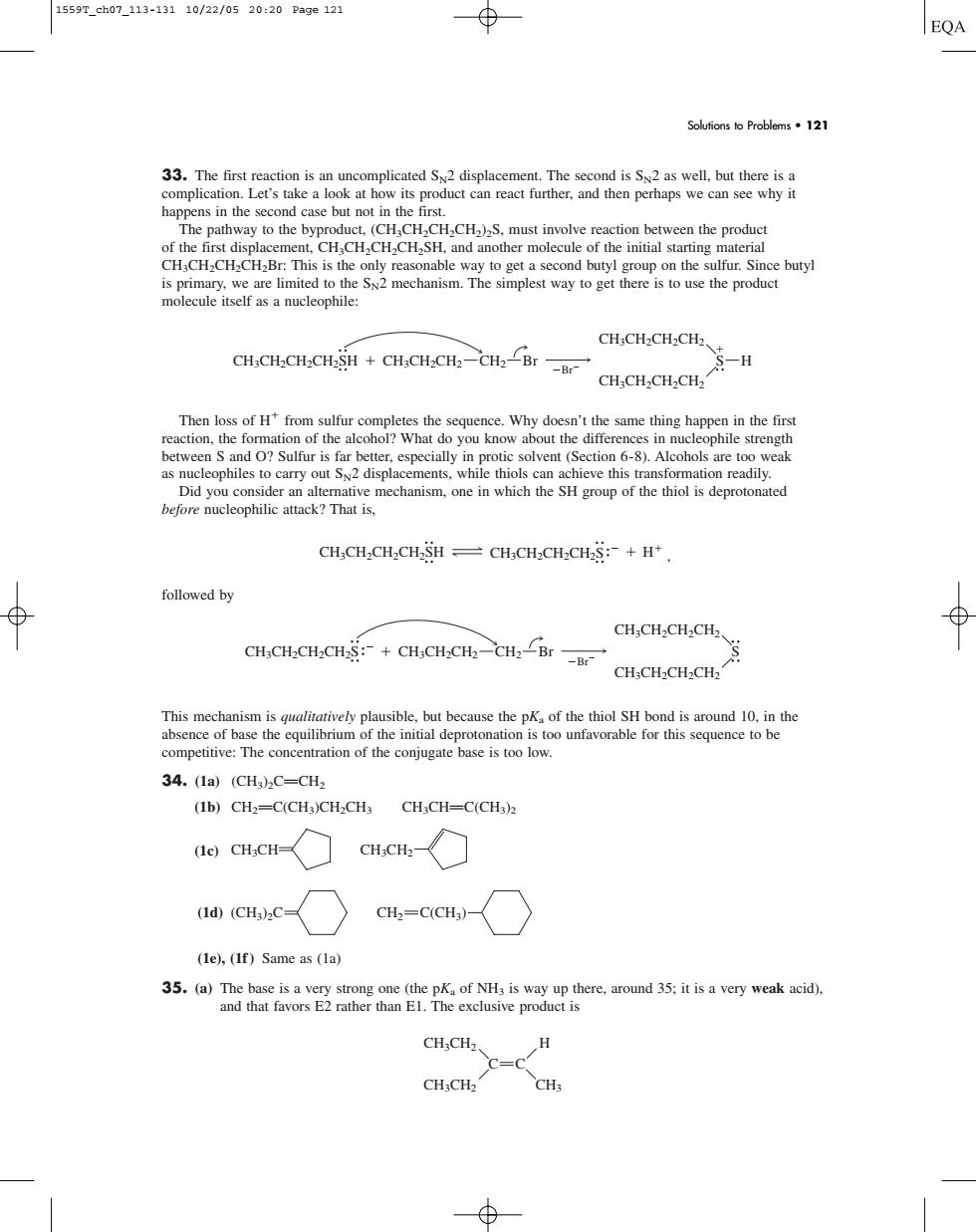正在加载图片...

1559T_ch07-113-13110/22/0520:20Pa9e121 EQA Solutions to Problems.121 happens in the second case but not in. aps we can see why the sulfur.Since butyl is primary.we are limited to the S2 mechanism.The simplest way to get there is to use the product molecule itself as a nucleophile Ch:Ch-CH-CH CH.CH.CH.CH.+CH.CH.CH-CH Brr CH.CH.CH.CH. Then loss of Hfrom sulfur completes the sequence.Why doesn't the same thing happen in the first as nucleophiles to carry out 2 displacements.whil thiols can achieve this ormation readily CHCH,CH,CH SH CH;:-+H* followed by CH.CH.CH,CH.+CH.CH-CH CHBr CH;CH2CH2CH2 CH;CH2CH2CH2 plausible but because the p&.of the thiol sHt competitive:The concentration of the conjugate base is too low. 34.(la)(CHg)zC-CH (1b)CH2=C(CH3)CH2CH;CH;CH=C(CH3)2 te)CH.CH-CH.CH (ld)(CH3)C= CH2=C(CH3)- (le),(If)Same as (la) CH,CH2、 CH 33. The first reaction is an uncomplicated SN2 displacement. The second is SN2 as well, but there is a complication. Let’s take a look at how its product can react further, and then perhaps we can see why it happens in the second case but not in the first. The pathway to the byproduct, (CH3CH2CH2CH2)2S, must involve reaction between the product of the first displacement, CH3CH2CH2CH2SH, and another molecule of the initial starting material CH3CH2CH2CH2Br: This is the only reasonable way to get a second butyl group on the sulfur. Since butyl is primary, we are limited to the SN2 mechanism. The simplest way to get there is to use the product molecule itself as a nucleophile: Then loss of H from sulfur completes the sequence. Why doesn’t the same thing happen in the first reaction, the formation of the alcohol? What do you know about the differences in nucleophile strength between S and O? Sulfur is far better, especially in protic solvent (Section 6-8). Alcohols are too weak as nucleophiles to carry out SN2 displacements, while thiols can achieve this transformation readily. Did you consider an alternative mechanism, one in which the SH group of the thiol is deprotonated before nucleophilic attack? That is, , followed by This mechanism is qualitatively plausible, but because the pKa of the thiol SH bond is around 10, in the absence of base the equilibrium of the initial deprotonation is too unfavorable for this sequence to be competitive: The concentration of the conjugate base is too low. 34. (1a) (CH3)2CPCH2 (1b) CH2PC(CH3)CH2CH3 CH3CHPC(CH3)2 (1c) (1d) (1e), (1f ) Same as (1a) 35. (a) The base is a very strong one (the pKa of NH3 is way up there, around 35; it is a very weak acid), and that favors E2 rather than E1. The exclusive product is C CH3CH2 CH3CH2 H CH3 C (CH3)2C CH2 C(CH3) CH3CH CH3CH2 CH3CH2CH2 CH3CH2CH2CH2 CH3CH2CH2CH2 CH2 Br Br CH3CH2CH2CH2S S H CH3CH2CH2CH2S CH3CH2CH2CH2SH CH3CH2CH2CH2SH CH3CH2CH2 CH3CH2CH2CH2 CH3CH2CH2CH2 CH2 Br Br S H Solutions to Problems • 121 1559T_ch07_113-131 10/22/05 20:20 Page 121������